-
Can You Spot the Thistle Feeders?
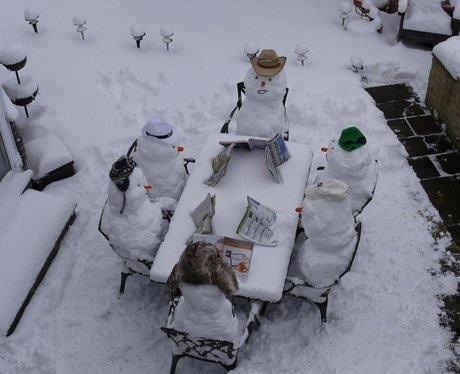 Me neither as they must be covered in snow and awaiting the big thaw. So this is April? Wisconsin, Minnesota, somewhere like that. Goldfinches are already shedding worn winter feathers and turning yellow, while other common resident birds are nesting in much of the country. Once again, will winter ever end?
Me neither as they must be covered in snow and awaiting the big thaw. So this is April? Wisconsin, Minnesota, somewhere like that. Goldfinches are already shedding worn winter feathers and turning yellow, while other common resident birds are nesting in much of the country. Once again, will winter ever end?Yesterday brought our first butterfly to the yard, but unfortunately the consecutive, way below normal night temperature this year zapped established lantana that was seven years old. You could always count on butterflies around those shrubs. Yes, that’s how big they were, mature shrubs.
Erratic weather is largely attributed to climate change, but many folks don’t see it that way. Mudslides, volcanoes, drought and rising sea levels to name a few effects are pretty apparent and scarily becoming the norm.
In the bluebird world, trail monitors found a record number of dead bluebirds in the KY area. A very late spring being the culprit after such a rough winter… there were simply no natural food sources available. Someone was inquiring about a feeder the other day and said “no rush, it’s for next year, we don’t really feed birds in summer”. We’ve come across many folks like that, but here’s the reality: weather directly affects food sources and bird’s survival rates.
Last summer through a wicked drought, we witnessed a male cardinal feeding a fledgeling from a platform feeder containing
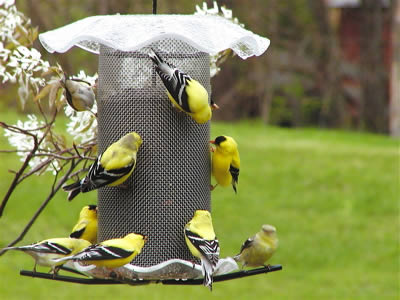 sunflower hearts. From ground to platform and back he flew feeding his offspring. It was a strange sight, as others were reported this winter too. Cardinals hanging on suet feeders, and ground-feeding juncos up at black oil feeders. Many of the migratory birds were in for a harsh surprise upon arrival into the gulf states. No flowers, no berries, no insects, simply an equation for starvation after a long journey like that.
sunflower hearts. From ground to platform and back he flew feeding his offspring. It was a strange sight, as others were reported this winter too. Cardinals hanging on suet feeders, and ground-feeding juncos up at black oil feeders. Many of the migratory birds were in for a harsh surprise upon arrival into the gulf states. No flowers, no berries, no insects, simply an equation for starvation after a long journey like that.Closer to home, resident birds braved a very tough season as well. Feeders were non-stop with activity for the most part. Although thistle feeders didn’t see too much traffic, other feeders containing finch mixes did… and a lot! Once the olive drab fliers began their molting process, straight nyjer became goldfinches’ food of choice and overnight, thistle was and is being devoured daily!
The good news is this seed has come down in price a little bit, and if you can manage the larger bags, like 20-to 40-pounders, you’ll save even more money this summer. Unlike other birds, goldfinches feed nestlings and fledgelings thistle-almost exclusively.
So if you’re not really a “summer feeder”, you may want to rethink maybe just one or two feeders this summer… the bird families sure will thank you!
-
Bird Brain Hummingbird Feeders for Citizen Science
 Audubon Invites Volunteers to Help Track Hummingbirds This Spring
Audubon Invites Volunteers to Help Track Hummingbirds This SpringTake your hummingbird feeders a step further by helping Audubon track the tiny sprites this season. All habitats and feeders are welcome; from the old bird brain hummingbird feeders to honeysuckle and trumpet vine to colorful annuals providing food…. watch near fountains too, another favorite of this flying jewel!
NEW YORK, NY (April 1, 2014) – With spring officially upon us, the National Audubon Society invites birders and nature enthusiasts across the country to help track the health of hummingbird populations with Audubon’s Hummingbirds at Home app. This citizen science project utilizes the power of volunteers to compile data at a scale that scientists could never accomplish alone.
Every spring, numerous hummingbirds migrate long distances and must eat several times their weight in nectar daily to stay alive. Hummingbirds visit our yards every year, looking for nectar from our gardens and feeders. As flowers bloom earlier because of warming temperatures, the impact on hummingbirds which rely on nectar could be significant. The degree to which hummingbirds are able to adapt to accommodate these changes is not completely understood. Hummingbirds at Home was designed to bolster current research by collecting data from volunteers across the country that offers important insight on the effects of climate change and the birds’ well-being.
“Increasingly people are seeing the impact of climate change in their own backyards, from early blossoms to extreme weather,” said Dr. Gary Langham, Chief Scientist at Audubon. “This is a fun, family-friendly citizen science project that works in the classroom or in the kitchen.”
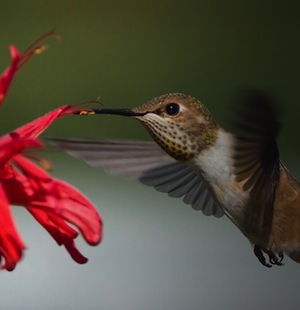
Hummingbirds at Home differs from other bird monitoring programs in that the focus is on recording the species, nectar sources, and feeding behavior observed. In the case of bloom timing mismatches, Audubon hopes to eventually learn if alternate nectar sources, like feeders, make a difference in hummingbird breeding success and survival.
Participants can get involved by spending a few minutes as frequently as they wish to collect invaluable data from feeding areas in their gardens and communities. Audubon’s Hummingbird at Home app makes it fun and easy. There is no cost to participate and using the free mobile app or website makes it simple to report sightings and learn more about these remarkable birds. For more information visit, www.hummingbirdsathome.org.
About Audubon
The National Audubon Society saves birds and their habitats throughout the Americas using science, advocacy, education and on-the-ground conservation. Audubon’s state programs, nature centers, chapters and partners have an unparalleled wingspan that reaches millions of people each year to inform, inspire and unite diverse communities in conservation action. Since 1905, Audubon’s vision has been a world in which people and wildlife thrive. Audubon is a nonprofit conservation organization. Learn more at www.audubon.org and @audubonsociety.
-
So What’s the Best Tube Bird Feeder for Spring?
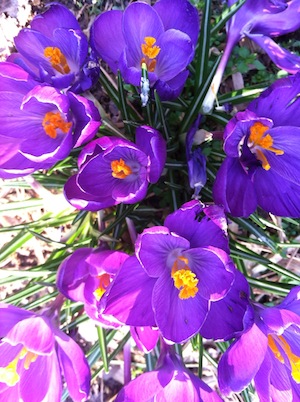 With spring in bloom (in much of the country anyway) there’s an instinct among nature types to get outdoors and work in the garden! For many, wild birds go hand-in-hand with love of gardening. Like the “eyes bigger than stomach” syndrome at a restaurant, heading into nurseries can easily turn into more than one bargained for! We know this first hand, as flowers sit in the driveway waiting to be planted.
With spring in bloom (in much of the country anyway) there’s an instinct among nature types to get outdoors and work in the garden! For many, wild birds go hand-in-hand with love of gardening. Like the “eyes bigger than stomach” syndrome at a restaurant, heading into nurseries can easily turn into more than one bargained for! We know this first hand, as flowers sit in the driveway waiting to be planted.Luckily for perennials like these crocus, color emerges effortlessly year after year. It also signals the beginning of nesting season for resident birds, and the migratory start for our southern feathered friends.
On the birding side, it’s a perfect time to give feeders a good cleaning, check birdhouses for old nests and clean them out too. Avoid leaving old nests on the ground near birdhouses as this attracts predators. Lots of fancy cleaners on the market, but a solution of bleach and water (1:10 ratio) is ideal. Scrub, rinse well, air dry… pretty simple.
If you’re just getting into the birding thing (lots of folks are these days) – where to start? So many feeders and gadgets out there! Fresh water and a
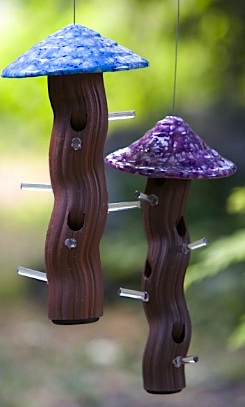 tube bird feeder are a great place to start! All birds are attracted to fresh water, be it a traditional birdbath, or simple pan of shallow water. Shallow’s the optimal word, 2-3-inches maximum is recommended. Something with texture too, as bird’s feet can get a better grip. Small rocks or pebbles in the bowl help with landing and perching.
tube bird feeder are a great place to start! All birds are attracted to fresh water, be it a traditional birdbath, or simple pan of shallow water. Shallow’s the optimal word, 2-3-inches maximum is recommended. Something with texture too, as bird’s feet can get a better grip. Small rocks or pebbles in the bowl help with landing and perching.So, what’s the best tube feeder? Like the bath, or anything else for that matter… it’s the one you will maintain! Feeders need to be filled fairly consistently, as well as cleaned. Wet, moldy seed serves no purpose at all, and birds will quit visiting a feeder with nasty contents. Plus it can spread disease among the local avian buddies in your yard.
Consider who you’d like to attract too. Thistle or nyjer seed is made for tube feeders, they have tiny ports for this tiny seed. Goldfinches, house and purple finches, siskins, buntings and redpolls enjoy thistle. Say you want a more “all-around” type feeder for chickadees, titmice, cardinals, nuthatches and some of the other usual suspects? You can’t beat a tube feeder with sunflower seed! It’s popular among many species and a great choice for a first or only feeder.
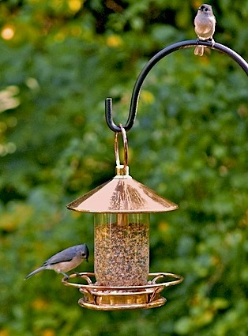 Some offer generous seed trays that make it easy for cardinals to feed. Although there are some general thoughts as to who will eat where, this winter proved all bets were off! Cardinals seen eating at suet feeders, juncos at sunflower feeders, and some other strange sightings due to the extreme weather.
Some offer generous seed trays that make it easy for cardinals to feed. Although there are some general thoughts as to who will eat where, this winter proved all bets were off! Cardinals seen eating at suet feeders, juncos at sunflower feeders, and some other strange sightings due to the extreme weather.The other really nice thing is that you can buy this seed sans the shell. Sunflower hearts (or meats) is a waste-free food that leaves hardly any ground mess. Whatever should fall to the ground is usually gobbled up by ground feeding birds like doves, juncos or chipping sparrows. It costs a few dollars more, but we think it’s well worth it! Cheaper seed leaves more waste because of the fillers most birds peck out and discard… so where’s the value?
In choosing a new tube bird feeder, pick one with sturdy construction that you know will last. Although inexpensive, plastic isn’t always the best choice as squirrels can and likely will chew it to bits. Ceramic is chew-proof, as is copper, stainless steel, and many of the newer materials used to hand craft or manufacture quality bird feeders.
Your birds will thank you!
